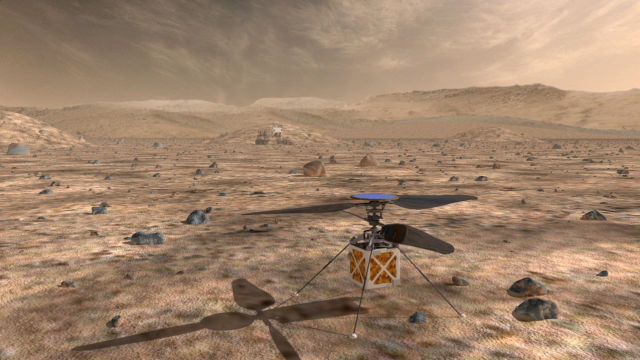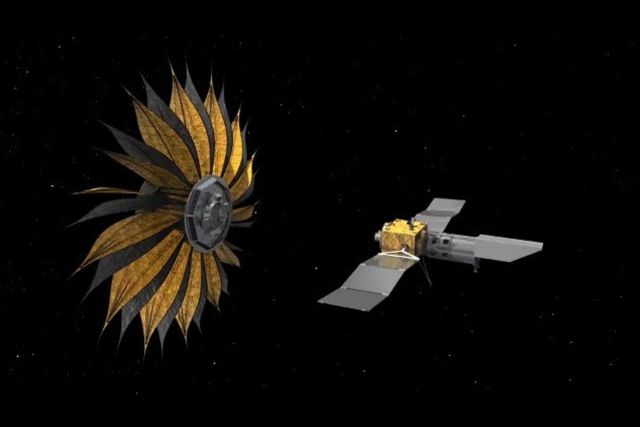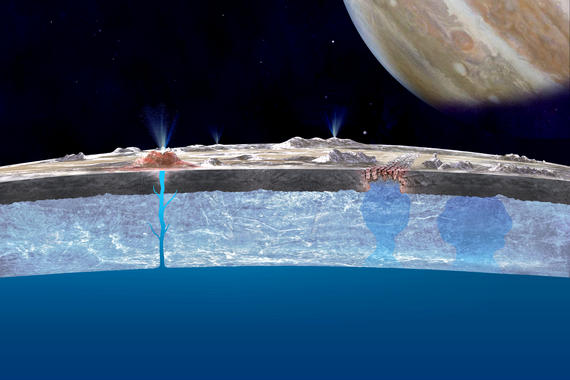
Can you image a tissue-sized device that is equipped with blades just a few feet in length, while whirring to life just after charging for an entire Sol on the planet Mars? This device is also capable of flying ahead of a rover to search for hazards, as well as other targets of interest. Deeper inside the solar system, on the Europa, there is a large spacecraft that lands near a fissure and then drops off small probes into the ocean below. Beyond the Moon, a telescope with a specially fitted shade will then provide images of an Earth-like exoplanet, which is clear for the first time. This possibly new finding of chemical markers of life upon another planet, is finally, after several decades, powered by the undreamed-of propulsion. The propulsion is a special spacecraft that takes off for the Alpha Centauri with speeds reaching a fraction of the speed of light.

All of this seems like it is a work of science fiction, however, a new budget for the NASA was proposed by the United States House of Representatives. This also includes money necessary for all of the initiatives, including some funding being received for the very first time. This new budget will also have to reconcile with that of the Senate. However, the House, as well as the Senate committees have also worked well in previous projects, to finalize NASA’s funding goals. Most of the base concepts can be expected to survive through the committees.
Ars was able to meet up with the author of the budget last Monday evening. John Culberson, who is a known and reputable Texas Republican, had also represented one of the most conservative districts within the conservative state of Texas, as well as a member of the Tea Party. Culberson also happens to be a science person, and is aiming to cut the federal budget. However, he had just ploughed those savings into NASA for a new type of fuel innovation.

NASA is aiming to launch a new curiosity sized rover onto the red planet Mars, in 2020. This new rover will have new instrumentation to aid in searching for any signs of past and present life on Mars. The 1kg helicopter that will have the full ability to scout ahead of the rover, flying for only 2-3 minutes a day, and then returning to the rover, in which it will spend the rest of the day recharging its solar-powered batteries.

Culberson’s most admirable project still remains within the search of life itself. He is also convinced that we will find any means of any existent life within our respective solar system, aside from that of what is on Earth. He believes that the oceans of Europa are the key to finding other life forms. The reported budget for this is projected to be $260 million and is set to launch in 2022. Shortly after that, a lander mission will be following in 2024. This is a mission to investigate the surface of Europa, as well as probe the oceans is an extreme priority in the world of planetary science community.
NASA has balked at the cost of a single mission to Europa, however, Congress is pushing the space agency into thinking bigger, while exploring the outer limits of our solar system. The intention is to send an initial mission to create dozens of flybys of Europa to gain a better understanding of the icy-surface of Jupiter’s moon. Thus, it will also potentially identify any fissures towards the ocean that are far below the icy layer of the surface. While the second mission, just two years later, will be carried by a lander, hopefully providing further investigations of the ice, and even possibly drop small probes into a few of those fissures.

Mr Culberson has also concluded that he will be meeting with the scientists and engineers behind the Jet Propulsion Laboratory for two days, to further discuss their latest ideas and concepts about the the lander. The congressmen are pushing the envelop aggressively, to find out how to break through the icy surface.
Just falling short of sending a spacecraft into orbit, and the ability to remote study Earth-like worlds that rotate around other stars, our scientists can only try to view exoplanets through large telescopes. However, this problem rests with these types of planets being exceptionally faint in comparison to other parent stars. A typical average exoplanet is normally around 10 million times fainter than the planets respective. star A JPL scientist, Gary Blackwood had once explained “It’s like trying to see a firefly next to a searchlight in Los Angeles, looking from New York City.”
In fact, NASA’s ‘Kepler’ spacecraft had found these exoplanets by searching for periodic, slight dimmings as the planets would pass right in front of their respect stars. However, the Holy Grail still remains, is to actually get a photograph of these amazing planets and then further study their constituent atmospheres in order to properly determine if Oxygen, Methane, and other important life-sustaining elements exist on those planets. NASA, as we all know, has some amazing and expensive instruments. Such instruments includes the James Webb Space Telescope, and we can not forget about the Transiting Exoplanet Survey Satellite that is coming within the next decade.

However, our best hope for studying planets and their atmospheres before 2030, will be done by a special type of telescope. This special telescope is designed to perform study and research on dark matter, as well as the expansion of the vast universe. This telescope – the Wide Field Infrared Survey Telescope (WFIRST) – is not completely optimized, however there is still a spectroscopic capability of the WFIRST that can be adapted to study the ExoPlanets. Engineers have already developed a special ‘Starshade’ technology that can be launched aside, and then position itself between the telescope and the entire star system of interest. This device will then be able to provide shelter of incoming light from the respective star, thus, isolating the light from the specified exoplanet.
The house bill has finally provided the organization with $10 million in funding to support the Starshade concept. This is the largest single financial infusion of known technology like the Starshade. This is also well needed for the acceleration of the project, if it were to have any chancesof optimized performance for the rendezvous with WFIRST’s prime main mission. Culberson has stated that this is the first technology he has seen that does not lose any photons from the respective exoplanets, and is aiming to see that the project will continue to move forward.
Man kind has been relying on chemical rocket powered propulsion for just under a century. NASA is currently undergoing extensive research ventures into solar electric propulsion. With this new line of propulsion, there comes new intriguing concepts surrounding nuclear thermal propulsion. However, none of the new systems, even while at their theoretical limits, are now able to come much closer to reaching new lines of maximum speeds, up to one-tenth of the speed of light.

This house bill is also directing NASA to consider a wide variety of Sci-Fi-like options. The research includes an antimatter-catalyzed fusion, the Bussard Interstellar Ramjet, Matter-Antimatter Annihilation Reactions, as well as multiple forms of beamed energy approaches, and immense “sails,” in which will ultimately intercept solar photons, or possibly solar wind. Culberson says that he is just throwing some ideas out in the open, allowing the engineers and scientists to lead us into a new future.
The law is encouraging the space organization, obviously within the limitations of the space technology budget funds, to study and develop a new propulsion concept that will enable a new line of interstellar scientific probes. This will allow us to achieve a new cruise velocity that will reach speeds up to 10% of that of the speed of light. Within a single year of the passing of the new budget, the agency is to develop a new interstellar propulsion technology assessment with a report of a draft “roadmap” to further study these brilliant ideas.
And the best part of all the new scientific research of propulsion concepts should also enable the launch of a new suitably fast robotic spacecraft into the Alpha Centauri by the year 2069, which happens to also mark the 100th anniversary of the Apollo Moon landings.
Sources: Arstechnica




